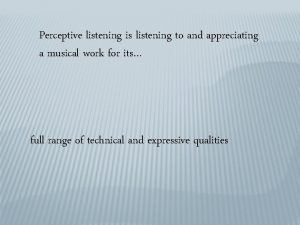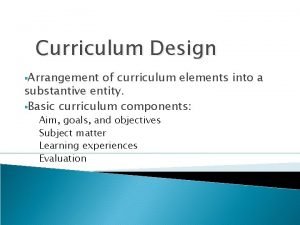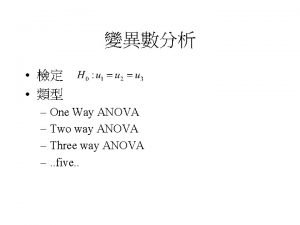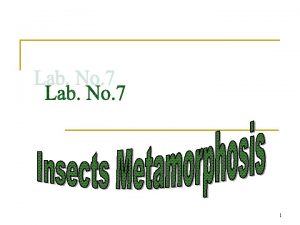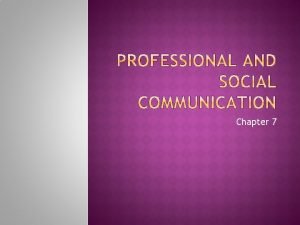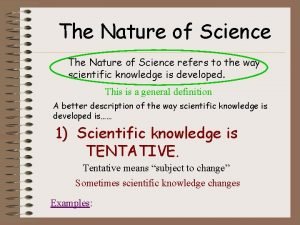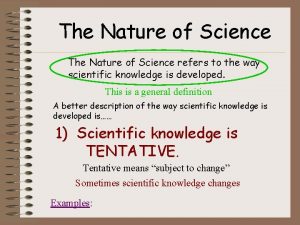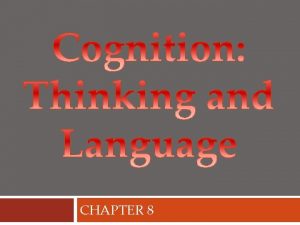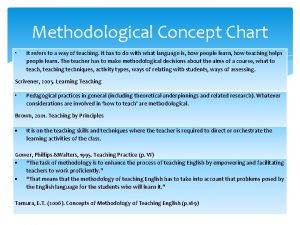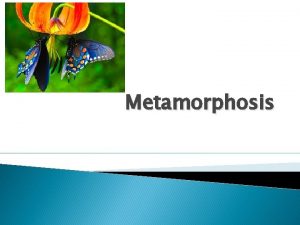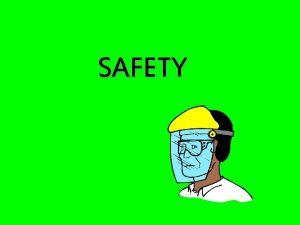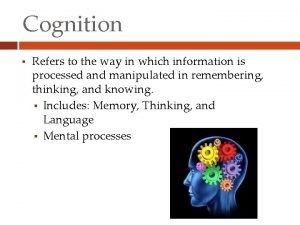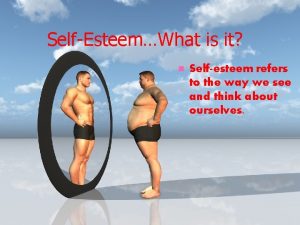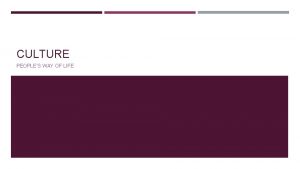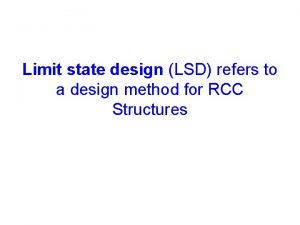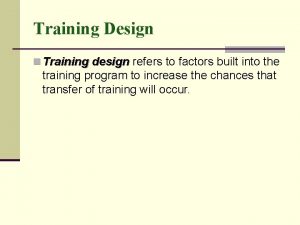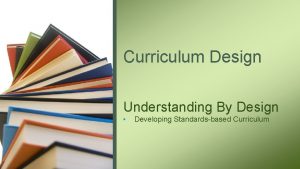Curriculum Design Curriculum Design refers to the way




























- Slides: 28

第二章 课程设计 Curriculum Design



课程设计是基于某种课程取向或课程理念,在课程 决策的基础上,利用一定的课程资源,对各种课程要 素进行计划、组织、编排,从而形成特定课程结构及 其物态课程产品的过程。 Curriculum Design refers to the way we conceptualize the curriculum and arrange its major components(subject matter, instructional methods and materials, learner experiences or activities) to provide direction and guidance as we develop the curriculum. (From Ornstein, A. C. p 18)




Three patterns of CD in TTD u CURRICULA BASED ON NEEDS OF LEARNERS u CURRICULA BASED ON ACADEMIC SUBJECT MATTER u CURRICULA BASED ON THE NEEDS OF SOCIETY



(二)学科课程的变式和发展式 1. 分科课程(Separate Subject Pattern) 2. 相关课程(Correlated Subject Pattern) Music and art ; history and geography; 3. 广域课程或融合课程(Fusion or Broad Fields) 也称为整合课程或综合课程(Integrated Curriculum)

It was an attempt to integrate content that appeared to fit together logically. Thus the separate social sciences of geography, economics, political science, anthropology, sociology, and history were fused into social studies. Linguistics, grammar, literature, composition, and spelling were collapsed into language arts. Biology, chemistry, and physics were integrated into general science.










主要参考文献 1. Ron Miller (1990) What Are Schools For ? , Holistic Education in American Culture, Brandon: Holistic Education Press. 2. Joel Spring (1991) American Education: An Introduction to Social and Political Aspects, fifth edition. New York and London: Longman 3. David G. Armstrong, etc (2001) Teaching Today: An Introduction to Education, Sixth Edition. New Jersey: Merrill Prentice Hall. 4. Forrest W. Parkay and Beverly Hardcastle Stanford (2001) Becoming A Teacher, fifth edition. Allyn and Bacon 5. Howard A. Ozmon and Samuel M. Craver (1999) Philosophical Foundations of Education, Sixth Edition. New Jersey: Merrill Prentice Hall. 6. Gerald L. Gutek (1997) Philosophical and Ideological Perspectives on Education, second edition, Allyn and Bacon 7. Gene D. Shepherd and William B. Ragan (1982) Modern Elementary Curriculum, Sixth Edition. CBS College Publishing. 8. Allan C. Ornstein and Francis P. Hunkins (1993) Curriculum: Foundations, Principles, and Issues. second edition, Allyn and Bacon

拓展阅读: Advantages of Curricula Organized Around Academic Subject Matter u As the most traditional form of organizing school programs, this pattern enjoys a certain respectability because of its long familiarity to parents and other patrons of the school. School programs organized in this way provide an aura of stability and continuity that many people find attractive. As a teacher, you may appreciate the security of knowing that you will be teaching familiar subjects. Administrators generally feel confident in explaining this kind of organizational pattern to parents. (TTD p 400)

Disadvantages of Curricula Organized Around Academic Subject Matter u Even though individual academic subjects have a certain internal consistency, it is by no means clear that the world is organized into history, mathematics, English , biology, and other separate subjects. The young people you will teach do not encounter a reality that is neatly sliced and filed into individual disciplines. Since reality is not divided into individual subject areas, some critics of the academic subject matter orientation suggest that the school curriculum should be more interdisciplinary in character. That is, individual courses should be organized in a way that allows content to be drawn from many sources. (TTD p 401)

Advantages of Curricula Based on Learners' Needs u Probably the most important strength of needs of learners programs is that they place concern for individual learners at the heart of the planning process. Such pro grams remind educators of their responsibility to serve young people and provide experiences that will help them to live rich and fulfilling lives. (TTD p 398)

Disadvantages of Curricula Based on Learners' Needs u Critics of curricula based on learners' needs often focus on the issue of efficiency. They point out that efforts you might undertake to diagnose and respond to special needs of each member of your class are not cost effective. These same critics would argue that it would not be practical for you to create unique programs designed to meet the special needs of each learner. In addition, people who challenge the appropriateness of curricula based on characteristics of individual learners feel that some content should be mastered by all young people, regardless of their levels of initial interest. (TTD p 398)

Advantages of Curricula Organized Around the Needs of Society u Needs of society curricula help young people integrate knowledge from a variety of sources as they use this knowledge to make sense of the world as it really is. u Supporters also point to the motivational advantages of organizing programs around reality. For example, if a class you are teaching is oriented toward a career in which some of your learners are interested, they are likely to have a personal desire to learn the material. A learner might find it much easier to master mathematics in the context of studying to become a pilot than by plodding through a traditional mathematics textbook page by page. (TTD p 405)

Disadvantages of Curricula Organized Around the Needs of Society u A major problem of the needs of society emphasis is the difficulty you can face as a teacher in identifying just which needs to address in school programs. There is a danger that these will be identified in haste and that the programs you develop will be excessively(too) narrow in scope and non substantive in content. u The rapidity with which needs change also poses difficulties. Some problems pass away; new problems emerge. Over time, technical changes alter job requirements tremendously. When educators view needs too narrowly, there is a danger that instruction will provide learners with information that will be obsolete(old) by the time they leave school. (TTD
 Texture refers to the physical and visual qualities of a
Texture refers to the physical and visual qualities of a Perceptive listening definition
Perceptive listening definition Key club meaning
Key club meaning Perbedaan one way dan two way anova
Perbedaan one way dan two way anova Explain threaded binary tree
Explain threaded binary tree Perbedaan one way anova dan two way anova
Perbedaan one way anova dan two way anova Hypothesis for two way anova
Hypothesis for two way anova One way anova vs two way anova
One way anova vs two way anova Apa itu two way anova
Apa itu two way anova Conventional software engineering
Conventional software engineering The one was a ship
The one was a ship Talk this way
Talk this way The arrangement of the elements of curriculum can be can as
The arrangement of the elements of curriculum can be can as Hình ảnh bộ gõ cơ thể búng tay
Hình ảnh bộ gõ cơ thể búng tay Lp html
Lp html Bổ thể
Bổ thể Tỉ lệ cơ thể trẻ em
Tỉ lệ cơ thể trẻ em Gấu đi như thế nào
Gấu đi như thế nào Tư thế worms-breton
Tư thế worms-breton Alleluia hat len nguoi oi
Alleluia hat len nguoi oi Kể tên các môn thể thao
Kể tên các môn thể thao Thế nào là hệ số cao nhất
Thế nào là hệ số cao nhất Các châu lục và đại dương trên thế giới
Các châu lục và đại dương trên thế giới Công thức tính thế năng
Công thức tính thế năng Trời xanh đây là của chúng ta thể thơ
Trời xanh đây là của chúng ta thể thơ Mật thư tọa độ 5x5
Mật thư tọa độ 5x5 Phép trừ bù
Phép trừ bù Phản ứng thế ankan
Phản ứng thế ankan Các châu lục và đại dương trên thế giới
Các châu lục và đại dương trên thế giới

